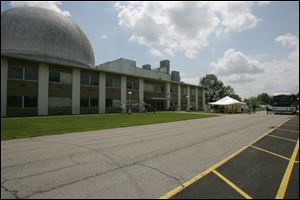
SANDUSKY
NASA official puts focus on private sector partnership
2nd-in-command tours Ohio research facilities
5/17/2013
Garver
GLOBE NEWSWIRE

The Space Power Facility at the NASA Glenn Research Center's Plum Brook Station in Sandusky, Ohio. At right is a shuttle stop for visitors.
SANDUSKY — NASA’s second-in-command toured the space agency’s Northern Ohio research facilities Thursday in an effort to cast attention on the capabilities they have and the work they’re doing with private sector companies whose dreams lie beyond the Earth’s atmosphere.
Though recent reports have called NASA’s Glenn Research Center in Cleveland and its Plum Brook Station outside Sandusky underused, NASA Deputy Administrator Lori Garver came with a message that the scope of research possible at the two facilities is critical.
Plum Brook Station, covering 6,400 acres just south of Sandusky, is unrivaled in its simulated space environment testing facilities. The station is home to the world’s largest vacuum chamber, the world’s most powerful low-frequency mechanical vibration test stand, and a recently added acoustic test chamber that is the world's most powerful. That chamber is currently occupied by SpaceX. The California-based private spaceflight company is using it to test a protective fairing that will cover components of the rocket upon launch.
Speaking in front of the massive acoustic chamber, Ms. Garver praised the work the space agency is doing with SpaceX and other private companies.
“We do believe we’re on this path with NASA that allows us to invest in technologies and innovation and facilities that can be utilized by the private sector so they can open up new markets, so they can innovate, and do those things we’ve been doing for a long time — in this case, go to low earth orbit,” Ms. Garver said. “We know we’ve been doing that for more than 50 years and we’re looking forward to going beyond with our own vehicles that will be tested here soon.”

Garver
NASA plans to begin testing on its upcoming Orion spacecraft at Plum Brook in the 2016 to 2017 time frame. Testing is under way with SpaceX, though the company is fairly mum on the specifics.
“Obviously you don’t get to space unless you launch. As you’re getting ready to launch, you test out all the modalites. It’s going to be a shaking ride, so on your way to orbit you want to make sure you’ve tested everything, that everything works the way you planned it to work,” said Adam Harris, vice president of government sales for SpaceX. “We’re seeing that happen here in this facility.”
Being able to do the testing on the ground at a place like Plum Brook is advantageous, he said.
“Having a facility like this is great for SpaceX, it’s great for this industry,” he said. “This infrastructure is something that is world class, and we’re very appreciative to have this partnership with NASA so that we can develop a capability that’s going to low-earth orbit that will help NASA but will also help the U.S. space industry.”
The acoustic chamber uses 36 horns of varying frequencies by using high-pressure hydrogen gas. SpaceX is the first customer to use it. Helping foster U.S. private sector space development in ways that aren’t possible elsewhere is a critical mission for NASA, Ms. Garver said.
“In addition, this particular partnership is to help test those capabilities that we in the government have been doing for a very long time so that we can invest our really, really valuable dollars doing the hard thing, the thing there really isn’t a market for right now. As we develop that and reduce that cost, ultimately we’ll continue to drive while the private sector comes along with us and everybody, including the taxpayer, benefits.”
Jim Free, Glenn’s director, said it’s important to showcase the research center by hosting events, bringing in visitors, and publishing research papers. “It’s really almost a marketing campaign in that sense of getting it out there, but it’s never out ahead of our job of working for NASA and we service our NASA customers first and foremost.”
About 120 people work at Plum Brook. In all, NASA says more than 3,400 people work at the Glenn Research Center.